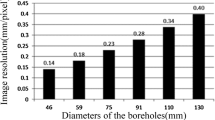Abstract
Rock mass integrity is regarded as an important index to evaluate rock mass quality. Core drilling technology is one of the effective methods used for this. To overcome the problem of core discing and core breakage from the drilling process, a new evaluation method was proposed: a rock mass integrity index (RMIBT) based on high-definition digital borehole televiewer data. The RMIBT values were obtained by measuring the mass proportions of the length of the rock mass without macroscopic fractures on the borehole wall. Their scoring criteria were determined based on rock quality designation. It was applied in multiple deep rock excavations and therefore proved to be useful, especially where core discing occurs, in specific spatial distributions of structural planes, as well as logging errors from core breakages induced by drilling. In addition, the RMIBT can be used to assess dynamically the integrity of macroscopic rock masses and the evolution of fractures in the excavation damaged zone, thus providing a basis for the evaluation of rock masses in deep rock excavations.

















Similar content being viewed by others
References
Barton N, Lien R, Lunde J (1974) Engineering classification of rock masses for the design of tunnel support. Rock Mech Rock Eng 6(4):189–236
Bieniawski ZT (1973) Engineering classification of jointed rock masses. Civil Eng S Afr 15:335–343
Deere DU (1964) Technical description of rock cores for engineering purposes. Rock Mech Rock Eng 1(1):17–22
Deere DU (1989) Rock quality designation (RQD) after 20 years. US Army Corps Engrs Contract Report GL-89-1. Waterways Experimental Station, Vicksburg
Dyke CG (1989) Core discing: Its potential as an indicator of principal in situ stress directions. IMHEF-LMH 17(6):681–684
Falls SD, Young RP (1998) Acoustic emission and ultrasonic-velocity methods used to characterise the excavation disturbance associated with deep tunnels in hard rock. Tectonophysics 289(1–3):1–15
Feng X, Hudson JA (2011) Rock engineering design. CRC Press, Boca Raton
Feng X-T, Yang CX (2001) Genetic evolution of nonlinear material constitutive models. Comput Methods Appl Mech Eng 190(45):5957–5973
Feng X-T, Yang CX (2004) Coupling recognition of the structure and parameters of non-linear constitutive material models using hybrid evolutionary algorithms. Int J Numer Meth Eng 59(9):1227–1250
Feng X, Zhang C, Qiu S, Zhou H, Jiang Q, Li S (2013) Dynamic design method for deep tunnels at hard rocks. Science Press (in Chinese)
Ishida T, Saito T (1995) Observation of core discing and in situ stress measurements; stress criteria causing core discing. Rock Mech Rock Eng 28(3):167–182
Kaga N, Matsuki K, Sakaguchi K (2003) The in situ stress states associated with core discing estimated by analysis of principal tensile stress. Int J Rock Mech Min Sci 40(5):653–665
Lau JSO, Auger LF, Bisson JG (1987) Subsurface fracture surveys using a borehole television camera and acoustic televiewer: reply. Can Geotech J 24(4):499–508
Li S-J, Feng X-T, Wang CY (2013) ISRM suggested method for rock mass fractures observations using a borehole digital optical televiewer. Rock Mech Rock Eng 46(3):635–644
Palmstrom A (1996) Characterizing rock masses by the RMI for use in practical rock engineering, part 1: the development of the rock mass index (RMI). Tunn Undergr Space Technol 11(2):175–188
Palmstrom A (2005) Measurements of and correlations between block size and rock quality designation (RQD). Tunn Undergr Space Technol 20(4):362–377
Sayers CM (1988) Inversion of ultrasonic wave velocity measurements to obtain the microcrack orientation distribution function in rocks. Ultrasonics 26(35):743–749
Takahashi T, Takeuchi T, Sassa K (2004) ISRM suggested methods for borehole geophysics in rock engineering. Int J Rock Mech Min Sci 41(6):885–914
Acknowledgements
The work is financially supported by the National Natural Science Foundation of China (Grants Nos. 41320104005, 11232024 and 51579043), and the State Key Research Development Program of China (Grant No. 2016YFC0600702). The authors appreciate the value added through discussion of the work with Dr. Ya-Xun Xiao.
Author information
Authors and Affiliations
Corresponding author
Rights and permissions
About this article
Cite this article
Guo, HS., Feng, XT., Li, SJ. et al. Evaluation of the Integrity of Deep Rock Masses Using Results of Digital Borehole Televiewers. Rock Mech Rock Eng 50, 1371–1382 (2017). https://doi.org/10.1007/s00603-017-1173-7
Received:
Accepted:
Published:
Issue Date:
DOI: https://doi.org/10.1007/s00603-017-1173-7




